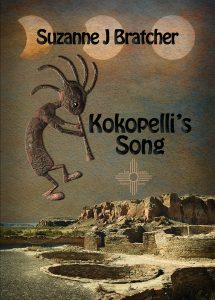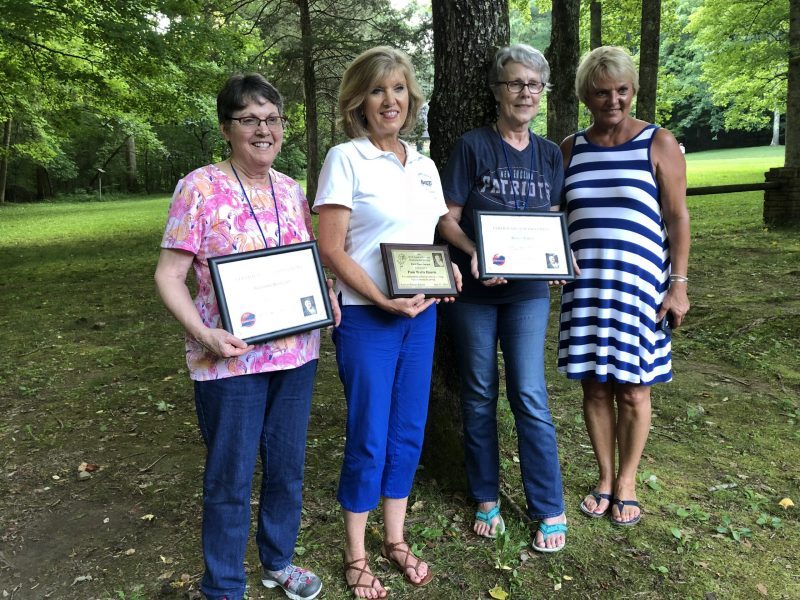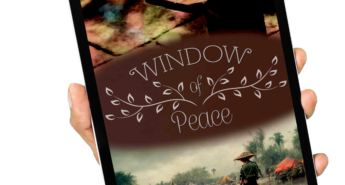Happy Wednesday!
 Fall has hit Western Kentucky with a vengeance! The trees have seemed to change colors overnight, and the temps have, too! Brrr!
Fall has hit Western Kentucky with a vengeance! The trees have seemed to change colors overnight, and the temps have, too! Brrr!
Today I’m thrilled to bring you author Suzanne Bratcher!
Suzanne’s books in The Jerome Mysteries, The Copper Box and The Silver Lode, were compelling reads, and I can’t wait to read her newest release, Kokopelli’s Song. Suzanne says this book isn’t Fantasy, per se, but what she likes to call, and hopes to bring to the forefront, “Magical Realism.” We may be in on the beginning of a new genre! I love it!
Today I’m bringing you the “story behind the story,” and I know you’ll find it as fascinating as I!
THE STORY BEHIND KOKOPELLI’S SONG
 Stories begin in all sorts of ways. A vivid character badgers her writer into discovering plot. A nagging conflict forces the writer to search for characters. Even a setting can grab hold, refusing to let go until the writer tells the stories that haunt that place. The most difficult stories to write begin with a title, leaving the author to uncover plot, characters, and even setting. Kokopelli’s Song started that way.
Stories begin in all sorts of ways. A vivid character badgers her writer into discovering plot. A nagging conflict forces the writer to search for characters. Even a setting can grab hold, refusing to let go until the writer tells the stories that haunt that place. The most difficult stories to write begin with a title, leaving the author to uncover plot, characters, and even setting. Kokopelli’s Song started that way.
Kokopelli, a flute player that appears on carved on rock faces from South America all the way to the pueblo ruins of Utah and Arizona, is a popular icon throughout the Southwest. He appears in flashing neon, on letterhead, on T-shirts, and in scholarly works. As familiar a figure as he is, no one knows what song he plays on his red cedar flute.
One afternoon the title Kokopelli’s Song popped into my head. It remained just a title for a couple of years—until the first time I visited Chaco Culture National Historic Park in New Mexico. As I hiked through the ruins left by an advanced civilization that flourished between the 900 and 1150 AD centuries, I could hardly take in what I was seeing. I had visited the pyramids in Mexico and read about Machu Picchu in Peru, but I had no idea anything like these massive ruins existed in the United States.
I bought a book, which led me to more books. I learned that instead of being a residential center like Mesa Verde, Chaco was a ceremonial center. People came from all over the Four Corners region (New Mexico, Arizona, Utah, Colorado) for ceremonies at different times of the year. The archaeological record showed that the ceremonies stopped abruptly. But, unlike most ancestral Puebloan (sometimes called “Anasazi”) centers, Chaco was not simply abandoned. Instead, the keepers dismantled the kivas (ceremonial rooms) with the same care used to build them, deliberately burning each kiva after it was dismantled. Archeologists knew burning was a purification ritual, but they didn’t know the cause of the desecration.
The more I read, the more intrigued I became. I returned to Chaco. On my second visit, I joined a ranger talk and learned about macaw feathers, seashells, and copper bells found in the kivas that proved trade between Chaco, South America, and even the west coast of North America. I hiked more of the ruins and saw a petroglyph that accurately tracked the complicated cycle of the moon, a path not discovered by any other civilization until the advent of computers.
The third time I visited Chaco, I camped under the stars. Early the next morning I heard the haunting strains of a Native American flute. I followed Kokopelli’s song, but I couldn’t find the flute player. As I left Chaco Canyon that day, a plot began taking shape in my imagination, a hero’s journey to keep ancient cosmic forces of evil from re-entering our world.
I found the journey on an antique rug in a home behind a trading post on the Hopi Reservation. The swastika, woven into the rug long before Hitler ever commandeered the ancient symbol for his evil empire, represented the legendary journey of the pueblo people to each of the four cardinal directions.
In my story West was Old Oraibi, a pueblo founded about the same time Chaco was closed. South was El Morro National Monument, the site of another prehistoric pueblo. East was Cochiti, a contemporary pueblo near Santa Fe, New Mexico. North was Chimney Rock National Monument, the ruin of a lunar observatory from the time of Chaco. Chaco Canyon was the Center. Since I had already visited Old Oraibi and Cochiti Pueblo, I made a trip to see El Morro and Chimney Rock.
Now my story needed compelling characters. As the plot and setting developed, I had Kokopelli, Chacoan witches trying to re-enter our world, and four shamans (one from each direction) determined to keep them out. I found the heroes in a Hopi legend about twins, a boy and girl, who were given special powers to survive a difficult journey. The twins in my story had one foot in each world. Separated because of their mother’s death when they were five, Amy grew up in Virginia; her brother Mahu (another Hopi word for Kokopelli) grew up on the Hopi reservation. It all began when Amy and Mahu were about to turn eighteen—on the day the thousand-year-old Tokpela Moon would open a door for the witches into our time.
Watch the trailer: http://bit.ly/KSongTrailer
About Suzanne Bratcher
Professor Emeritus, Northern Arizona University, Suzanne J. Bratcher lives in the foothills of the Ouachita Mountains of central Arkansas with her two rescue cats, Scamp and Mini Pearl. A passionate reader since her first encounter with Dick and Jane, she delights in spinning adventures set in the majestic, mysterious Southwest. She is the author of The Copper Box, The Silver Lode, and Kokopelli’s Song. When she’s not writing, she reads, quilts, and watches the many birds that come to her feeders.
Visit her webpage and read her blog at https://suzannebratcher.com.
Follow her on Facebook at https://facebook.com/authorsuzannebratcher
Follow her on Instagram at https://instagram.com/suzanne.bratcher.5/
About Kokopelli’s Song
When seventeen-year-old Amy Adams finds her father’s family and a lost twin brother on the Hopi reservation in Arizona, she stumbles into a struggle between shamans and witches that spans a thousand years. After Mahu is attacked and a Conquistador’s journal stolen, Amy and her new friend Diego set out on a dangerous quest to find and perform the ceremony that can stop ancient evil from entering our world.
But Amy and Diego are not alone as they race against time measured by a waxing moon. Kokopelli’s song, the haunting notes of a red cedar flute, guides them along the migration route sacred to pueblo peoples: West to Old Oraibi, South to El Morro, East to Cochiti Pueblo, North to Chimney Rock, and finally to the Center—and the final confrontation—in Chaco Canyon.
Buy Link: https://bit.ly/KokopellisSong

Here’s Suzanne (far left) as a finalist for the 2018 Sandra Robbins Inspire Award at the Ken-Ten Writers Conference!
Doesn’t Kokopelli’s Song sound fascinating?
If you’d like to be entered into a drawing for either an ebook or paperback copy of Kokopelli’s Song, leave a comment!
Have a great week – and stay warm! 🙂




The book sounds fascinating! I love the interview and all the research that went into the history and legends.
Based on your recommendation of all of Suzanne Bratcher’s fiction works, Regina, I’ve already popped over to our county library’s online catalog and reserved her award-winning debut novel, The Copper Box. And I can hardly wait to read Kokopelli’s Song. Magical realism, huh? That’s right up my alley. BTW, the trailer is very intriguing, especially with that haunting cedar flute playing in the background. Some authors these days are as creative in their marketing as they are in their writing. Thank you, Regina, for introducing us to Professor Bratcher and her works.
Nancy, you won’t be disappointed! Loved The Copper Box!!
Wow, what an extensive research!
This book sounds interesting. Would love to read and review in print format.
You did a lot research.
Thank You.
Hope I Win.
Sounds very interesting – thanks for the giveaway!
I really found it all fascinating and I have discussed it with my 10 year old great granddaughter as we have been studying about it in virtual school studies. I was very thrilled to have been gifted an ebook copy of it. Thank you so much Susan. Stay blessed.
This book sounds like such a very good read! And I love the cover! Thank you so much for the chance.
sounds interesting!
Since I live in New Mexico, I have long been fascinated with the kokopelli figures. I have just not delved into research so I am totally intrigued with the summary and characters in this book. Good for you that you have spent much time investigating the history of Southwestern culture.
Sounds very interesting!
After reading this post I am going to buy Kokopelli’s Song even though I don’t usually read anything that sounds a little like fantasy. Suzanne’s book The Copper Box was so good that I don’t think Suzanne would steer me wrong on this one either.
Connie, I’m the same way – only for Suzanne! It’s waiting on my Kindle now!
Thank you to everyone who has commented! It was a fun book to write.